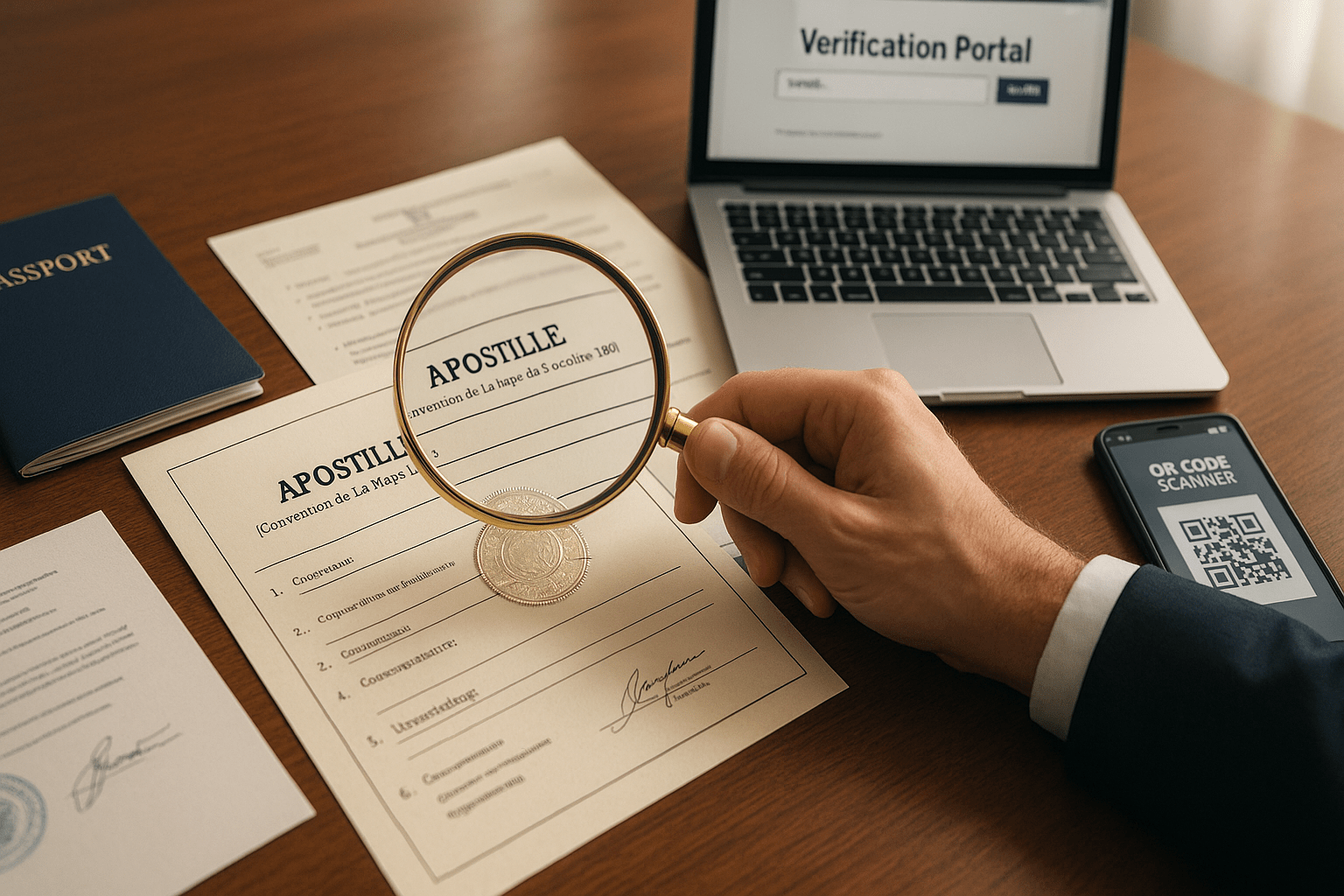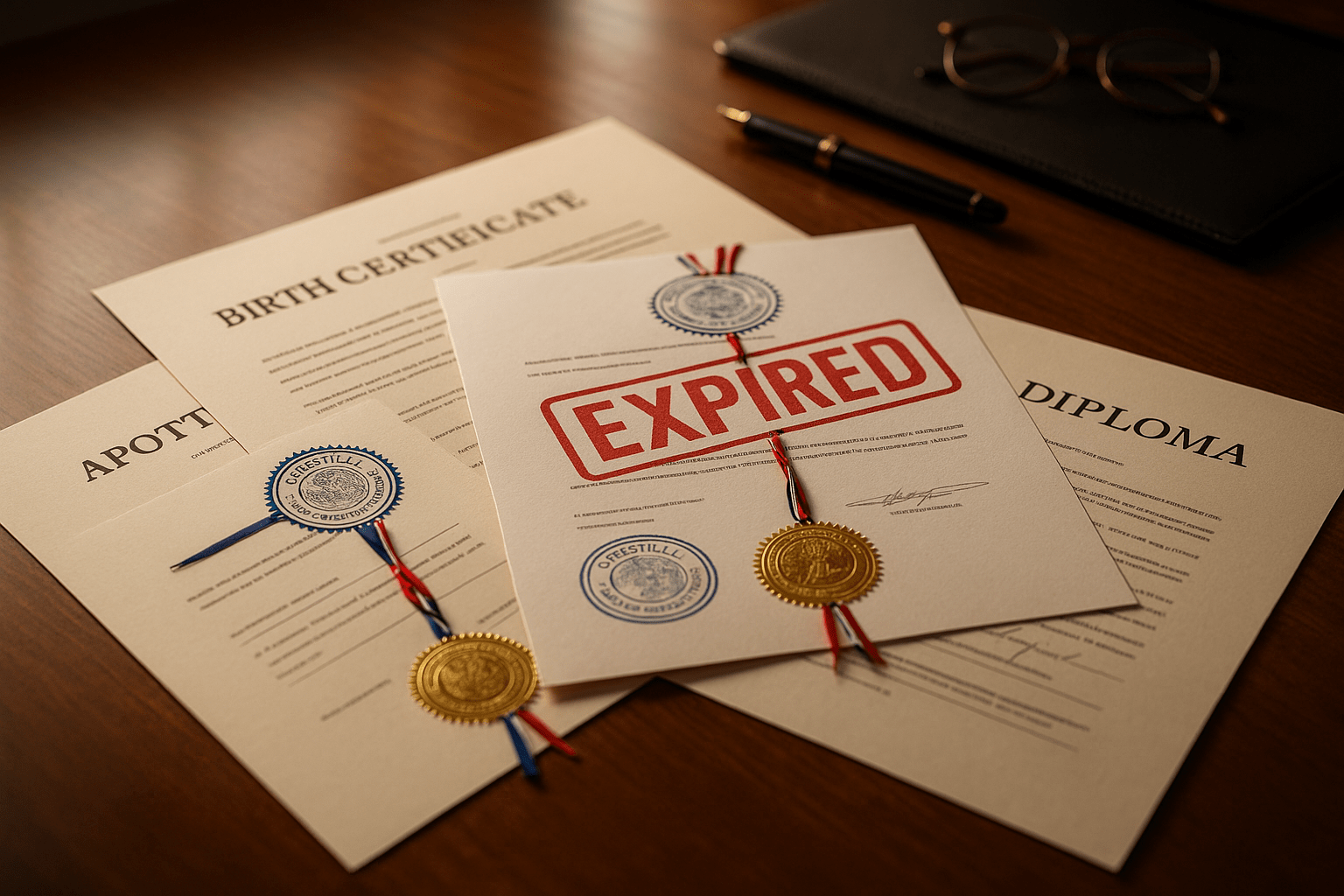
How to Check if An Apostille is Valid?
You’ve just found an apostilled document in your files and wondered if it’s legit? Before you send it across the globe, take a few moments to verify the apostille and confirm the certificate’s legitimacy. But, how do you know with confidence that foreign officials won’t reject it because of an inauthentic seal? This comprehensive guide will help ensure that the apostille is valid and recognized abroad.
Why Verifying an Apostille’s Authenticity Matters
An apostille is the key to international acceptance for your paperwork. If that key is faulty, all the hard work you’ve put in might fall apart, especially when your international plans hinge on official recognition. Hence, confirming the validity of your apostille is like a final quality check.
Consequences of Using an Invalid Apostille
Submitting a fraudulent or inadequate apostille to foreign governments can result in severe setbacks. They may reject the document outright, causing you to restart the process all over and wasting precious resources. In the worst cases, it could raise legal complications in the destination country, such as a failed contract, a denied residency permit, or a penalty for document fraud.
When Verification Becomes Necessary
Double-checking your apostille’s validity is always advised, but certain high-stakes scenarios make this step non-negotiable. Crucial circumstances include:
- Submitting paperwork for a visa application.
- Enrolling in a study abroad program.
- Finalizing a business deal or opening a branch office overseas.
Ultimately, assuming your current apostille works without performing a validity check is a risk you can’t afford. A proactive approach to verification acts as your safety net in these situations.
Key Features of a Genuine Apostille Certificate
The apostille is a standardized method of authentication, and its key features must remain consistent. While looks might shift a little among issuing authorities, spotting a legitimate apostille begins with looking for these core components.
Official Format and Design Elements
A true apostille adheres to the specific layout set by the Hague Convention. You’ll find the title “Apostille (Convention de La Haye du 5 octobre 1961)” at the top. The body contains ten numbered fields stating information such as the country of origin, date of issuance, and certifying official details. The design might feature intricate, unique borders or watermarks, depending on the states and jurisdictions.
Issuer Authority and Reference Number
The certificate clearly shows the name of the official authority that issues it, typically the Secretary of State of a particular state or the U.S. Department of State. An apostille reference number accompanies this for verifying validity through the issuer’s official registry or channel. Any missing detail here is a huge red flag.
Security Features: Seals, Signatures, and QR Codes
Authentic apostilles must be equipped with robust security features. You’ll often see a raised, embossed seal and an ink signature of the apostille processor. Some places currently include a QR code for digital tracking. Simply scan it using your phone, and you’ll be redirected to an online verification portal.
How to Verify an Apostille Manually
Despite digital verification becoming more and more popular, manually inspecting the certificate remains a vital skill. Doing this properly requires careful observation, and here’s what to do:
Process for Paper Apostilles
Conduct a physical assessment of the apostille’s layout. Remember that it should follow the Convention format with ten numbered sections. Then, check the underlying document to see if it matches the details provided in the apostille. Finally, the apostille must be printed on high-quality paper with sharp text, signature, and seal.
Where to Confirm the Issuing Authority
The paper certificate always states the issuing government body, such as “Office of the Secretary of State of California.” After you find this information, visit the official verification page of the issuing authority or contact the office directly to confirm the apostille’s authenticity using its unique reference number.
Common Errors That May Indicate a Fake Document
Be aware of obvious signs such as typos, grammatical errors, printed signatures, or smudged seals. More importantly, apostilles that lack a reference number or include one that doesn’t follow the standard format are almost certainly forged. In short, true apostilles must have all security features present, and the issuing authority must be a verifiable government body.
How to Check an e-Apostille or Digital Apostille
Offering convenience and much faster processing times, electronic apostilles, or e-Apostilles, are widely accepted today. The principles of verification are essentially similar for these non-physical certificates — you’ll rely on digital tools to confirm their authenticity.
Accessing Online Verification Portals
Most authorities offer secure online verification portals where you can verify a digital apostille. You’ll need to enter the reference number into the search box and receive an instant confirmation whether it’s valid and on record.
Validating Digital Signatures and QR Codes
e-Apostilles come with cryptographic digital signatures that can be verified by PDF readers or signature validation software. You may also want to scan the provided QR code, if any, which will lead you to the official government verification page. If the link is broken or redirects you to an unrecognized site, this may indicate that your digital apostille is invalid.
Examples of Official Verification Platforms by Country
Every country has its own dedicated system for apostille verification. In the U.S., you can check the relevant Secretary of State’s e-Registry to confirm the legitimacy of digital apostilles issued by that state. Internationally, many Convention countries operate national e-Registries for verification, such as:
- France: Registre des apostilles et des légalisations.
- India: The eSanad platform.
- Australia: The DFAT online verification system.
It’s important to verify through official websites only and refrain from providing your personal details on any generic or suspicious platforms.
Recognizing Red Flags of a Fake Apostille
Even the most convincing fake apostilles are easy to identify if you know the warning signs. If your apostille has the following issues, it’s a strong indication to inspect further before sending the document abroad.
Incorrect Format or Layout
An authentic apostille must have an official appearance outlined by the Convention. Be wary of certificates that lack the ten numbered fields, omit the title “Apostille,” or use unaligned fonts — they’re likely unauthentic.
Missing or Altered Reference Numbers
The most critical element of every apostille is the unique identification number. Without it, the receiving authority will be unable to verify your document, resulting in immediate rejection. Similarly, if this number is smudged, retyped, or appears to have been tampered with, it’s a major sign of forgery.
Suspicious Notary or Authority Information
If the certificate lists a public notary with an expired commission or an unverifiable issuing authority, there’s a high chance that it’s fake. Also, cross-check the signature and seal to ensure that they match the government’s records. Any misalignments of name or capacity could suggest counterfeit.
What to Do if You Suspect an Invalid Apostille
Don’t panic if you discover a potential fake. When you feel that something is off about your apostille, taking action quickly will prevent serious consequences and get your document revalidated on time for its global journey.
Contacting the Issuing Authority for Confirmation
Go directly to the source to inquire about the apostille’s authenticity. Contact the government office that issued the certificate and provide any necessary information, such as the reference number or date of issue. They will confirm whether it’s recorded in the system.
Requesting Reissuance or Reauthentication
If the apostille is indeed invalid, you must start the process one more time. This often involves obtaining a certified copy of the document and submitting a formal request for apostille processing at the correct government office. Sometimes, it requires reauthentication for countries that don’t belong to the Hague Convention.
How Professional Apostille Services Can Help
Expert apostille service providers can quickly pinpoint the problems, communicate with the concerned authorities on your behalf, and navigate the reissuance process efficiently. These agencies are your go-to advocates when you’re short on time or unsure about how to replace an invalid apostille, guaranteeing the new one is flawless and complies with international laws.
Tips to Ensure Apostille Validity Before Use Abroad
Getting an apostille isn’t the endgame — verifying its validity is the final crucial step for international recognition. These insider tips will help you secure apostille validity for your USA paperwork and avoid frustrations while you’re overseas.
Always Verify the Signatory Before Apostille
Before submitting the document for an apostille, confirm that it was signed by someone with the capacity to do so. For instance, a public notary must be licensed and in good standing, or a state agency must be authorized to issue vital records. Apostilles might be denied abroad if the signatory isn’t recognized.
Confirm Hague Convention Membership of the Destination Country
Only nations participating in the Hague Convention accept the apostille. If your destination isn’t a member, you’ll need a different process called legalization. Hence, check the country’s membership status beforehand to prevent wasted effort.
Keep Both Original and Verified Copies Securely
Once you obtain the apostille, store the original and verified copies in a safe place, such as your travel folder. You can also make digital copies for backup, but many foreign authorities ask for the physical version, so having both is a strategic move.
Beyond the Stamp: Your Guarantee of Global Acceptance
Don’t let that faint signature derail your entire international plan. It’s worth a careful investigation into the apostille’s validity for peace of mind. Let our specialists verify your apostille today, so you can present it with absolute certainty wherever your aspirations lead.
FAQ
We have clear, concise answers for the most common questions about the validity of apostilles in this section.
Can an Apostille Expire or Become Invalid Over Time?
No, an apostille itself doesn’t have an expiration date; however, the underlying document might be time-sensitive, depending on its specific purpose.
Is an e-Apostille Accepted in All Countries?
Not every country accepts e-Apostilles yet, so you should check the destination’s current policy in advance.
Who Can Help Verify the Authenticity of My Apostille?
The authority that issued your apostille is the best source for verification, but a reputable service provider can also assist you in managing this process.
Can I Verify an Apostille Issued in Another Country?
Absolutely! You can reach out to that country’s competent authority or use the official e-Registry to confirm the apostille’s genuineness.
What Should I Do if My Apostille Was Rejected Abroad?
Ask for clarification from the receiving institution first, and then request a new apostille if necessary. You may also seek help from an expert service to determine whether the rejection reason is with the apostille itself or external factors.





